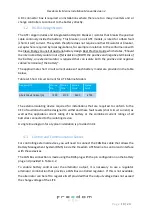
Freedom Lite Marine Installation Manual Revision 3
P a g e
10 | 24
A DC connector box is required on installations where there are too many inverters and or
charge controllers to connect to the battery directly.
4.2.
DC Bus Design Notes
The LiTE range includes and integrated battery DC breaker / isolator that breaks the positive
cable continuity inside the battery. This breaker, on all LiTE models, is rated for a 36kA fault
(short circuit) current. The system therefore does not require another DC isolator or breaker,
except where required by local regulations, for example in relation to the conformance with
the Clean Energy Council of Australia battery design Best Practice Guide which states,
“Should
the internal battery isolator not offer isolation of BOTH the positive and negative terminals of
the battery, an external isolator is required that can isolate both the positive and negative
cables/ terminals of the battery”.
The approximate short circuit current values of each battery model are provided in the table
below.
Table 4.1 Short Circuit Current for LiTE Marine Models
Freedom LiTE
Marine
5/4
Marine
10/8
Marine
20/16
Marine
30/24
Short Circuit Current [A]
1500
2100
3600
4700
The external isolating device required for installations that are required to conform to the
CEC of Australia should be designed to withstand these fault levels (short circuit current) as
well as the applicable current rating of the battery or the combined current ratings of all
batteries connected to the isolating device.
A single line diagram for a typical installation is provided in 4.1
4.3.
Control and Communication Cables
For controlling external devices, you will need to connect the CAN Bus cable that allows the
Battery Management System (BMS) inside the Freedom LiTE Marine to control and interface
with these devices.
The CAN Bus connection is made using the RJ45 plug with the pin configuration on the battery
plug end provided in Table 4.2.
To enable battery control over the alternator output, it is necessary to use a regulator
alternator combination that provides a CAN Bus controlled regulator. If this is not available,
the alternator can be left to regulate itself provided that the output voltage does not exceed
the charge voltage of the LiTE.










































